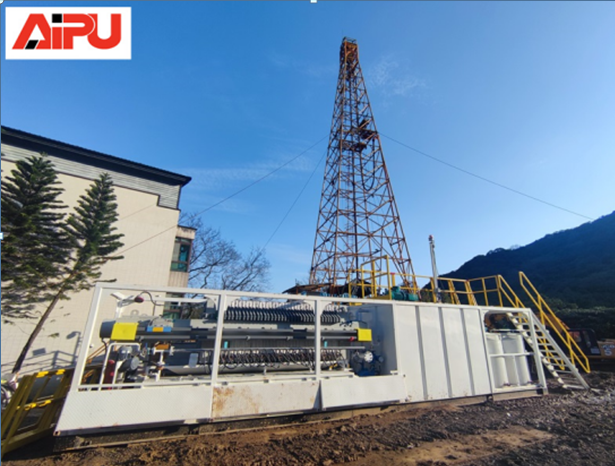Enhancing Efficiency and Performance in Drilling Operations
Modern drilling operations are complex and require advanced technologies to ensure efficiency and safety. One such essential technology is the solids control system, which plays a vital role in maintaining the quality of drilling fluids and the overall success of the drilling process.
Function of Solids Control System
The primary function of a solids control system is to separate the cuttings and other solid particles from the drilling fluid. During the drilling process, the drill bit breaks the rock formations, generating a large amount of cuttings. If these cuttings are not removed from the drilling fluid, they can cause various problems. For example, excessive solids in the drilling fluid can increase its viscosity, which may lead to poor hole cleaning, reduced drilling efficiency, and even damage to the drilling equipment. By effectively removing the solids, the solids control system helps to maintain the proper properties of the drilling fluid, ensuring smooth drilling operations.
Components of Solids Control System
A typical solids control system consists of several key components. The shale shaker is the first stage of solids control. It uses vibrating screens to separate the larger cuttings from the drilling fluid. The desander and desilter are the next steps, which use hydrocyclones to remove the finer solid particles. The centrifuge is another important component, which can further separate the very fine solids from the drilling fluid. Each of these components has its own specific function and working principle, and they work together to achieve efficient solids control.
Benefits of Using Solids Control System
There are numerous benefits to using a solids control system in modern drilling operations. Firstly, it can significantly reduce the cost of drilling. By maintaining the quality of the drilling fluid, the need for frequent replacement of the fluid is reduced, which saves both time and money. Secondly, it improves the safety of the drilling process. The removal of solids from the drilling fluid helps to prevent equipment failures and accidents, protecting the lives of the workers and the integrity of the drilling site. Additionally, a solids control system is environmentally friendly. It reduces the amount of waste generated during the drilling process, minimizing the impact on the environment.
Future Development of Solids Control System
As the demand for oil and gas continues to grow, and the drilling operations become more challenging, the solids control system is also expected to develop further. Future systems may be more automated, with advanced sensors and control algorithms to optimize the solids control process. They may also be more compact and energy - efficient, meeting the requirements of different drilling environments. Moreover, the integration of new materials and technologies may lead to more effective separation of solids, improving the overall performance of the solids control system.
In conclusion, the solids control system is an indispensable part of modern drilling operations. Its functions, components, benefits, and future development all contribute to the success and sustainability of the drilling industry.

Function of Solids Control System
The primary function of a solids control system is to separate the cuttings and other solid particles from the drilling fluid. During the drilling process, the drill bit breaks the rock formations, generating a large amount of cuttings. If these cuttings are not removed from the drilling fluid, they can cause various problems. For example, excessive solids in the drilling fluid can increase its viscosity, which may lead to poor hole cleaning, reduced drilling efficiency, and even damage to the drilling equipment. By effectively removing the solids, the solids control system helps to maintain the proper properties of the drilling fluid, ensuring smooth drilling operations.
Components of Solids Control System
A typical solids control system consists of several key components. The shale shaker is the first stage of solids control. It uses vibrating screens to separate the larger cuttings from the drilling fluid. The desander and desilter are the next steps, which use hydrocyclones to remove the finer solid particles. The centrifuge is another important component, which can further separate the very fine solids from the drilling fluid. Each of these components has its own specific function and working principle, and they work together to achieve efficient solids control.
Benefits of Using Solids Control System
There are numerous benefits to using a solids control system in modern drilling operations. Firstly, it can significantly reduce the cost of drilling. By maintaining the quality of the drilling fluid, the need for frequent replacement of the fluid is reduced, which saves both time and money. Secondly, it improves the safety of the drilling process. The removal of solids from the drilling fluid helps to prevent equipment failures and accidents, protecting the lives of the workers and the integrity of the drilling site. Additionally, a solids control system is environmentally friendly. It reduces the amount of waste generated during the drilling process, minimizing the impact on the environment.
Future Development of Solids Control System
As the demand for oil and gas continues to grow, and the drilling operations become more challenging, the solids control system is also expected to develop further. Future systems may be more automated, with advanced sensors and control algorithms to optimize the solids control process. They may also be more compact and energy - efficient, meeting the requirements of different drilling environments. Moreover, the integration of new materials and technologies may lead to more effective separation of solids, improving the overall performance of the solids control system.
In conclusion, the solids control system is an indispensable part of modern drilling operations. Its functions, components, benefits, and future development all contribute to the success and sustainability of the drilling industry.








